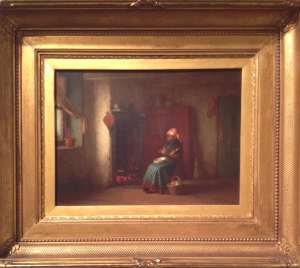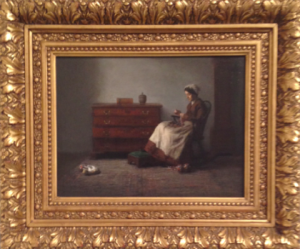[Seymour Lipton. Lynched, 1933. Mahogany.]
I could hardly look at this piece, because it was so vocal that I felt like it was screaming in my face. I felt as if I was trespassing… as if I should look away, out of respect for the dead. But then I realized that I wasn’t trespassing; after all, the artist clearly wanted people to look at his sculpture, or else he wouldn’t have created it. I only felt uncomfortable because it was forcing me to look at an ugly truth.
This piece was made in 1933, a time when lynching was still common, and a time when the president still refused to support legislation that would make lynching a federal crime.
The way this unnamed man’s body is naked and contorted on the ground in the fetal position is a graphically physical representation of the pain, oppression, and dehumanization that black Americans were being subjected to during this time period.
In the context of our current society, this sculpture carries massive weight, bringing to mind Mike Brown in particular. His dead body, riddled with bullets, was left on the street for four hours before being attended to. How is this any different from the discarded, lynched body in the sculpture? How have we progressed as society, when the lives of black Americans are still treated so lightly?
Thus, this sculpture forces us to look at and acknowledge what we don’t want to see, and to consider the treatment of the black community today. It begs the question: has anything really changed?
[Platt Powell Ryder. By the Hearth, 1877. Oil on canvas.] [Philip B. Hahs. Olden Time, 1880. Oil on canvas.]
Two completely different artists produced these two paintings, only three years apart. However, the curators at the Palmer were clearly making a deliberate decision in placing these paintings directly beside each other.
The white woman sits in her chair with her needlepoint work, most likely for leisure. The black woman, however, sits in her chair skinning vegetables… most likely not for leisure.
This juxtaposition asks us to acknowledge the very different lives of black women versus the lives of white women–and at the same time, asks us to acknowledge the similarities, and the shared experience of female subjugation by male-dominated power structures.



Wow I would not of been able to analyze this without your perspective. The sculpture is twisted and really does make you feel uncomfortable; now knowing the time period it gives me chills to think about how the sculpture depicts death. The difference you pointed out between the two women was also were keen, and how their actions were different than each other.
The sculpture was hard to look at, but like you said, makes us look into serious issues that need to be fixed. Even now there is still racial and sexism quite prevalent in our society and as a society we really need to fix these issues. I really liked your insight and description of the work, it helped me begin to focus on examining the entire picture.
Wow! You are very insightful. I could would have never see what you saw from those pieces of artwork. Most impressive was you noticed the careful placement of the two very similar artworks and the placement was purposeful. Next time, I need to be sure not to just look at the subject of a painting, but also the placement of artwork and the others around it as it gives a message on its own. Thanks for the insight!
I agree that the sculpture you first talked about was very hard to look at, and it portrayed the violence of the lynchings very well. The placement of the two different paintings very close to one another serves to emphasize the differences between women of different races at this time. I did not think so much into how they demonstrate the overall subjugation by men, and I think you did a very good job explaining this.